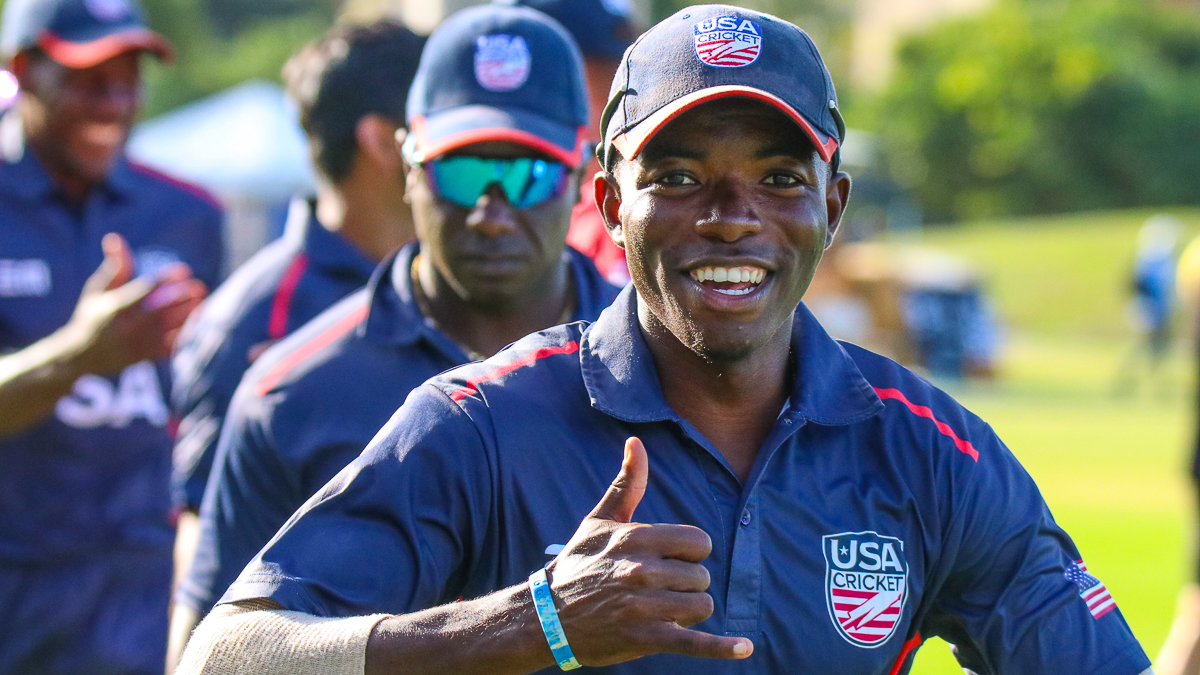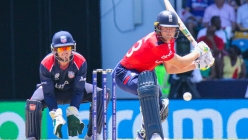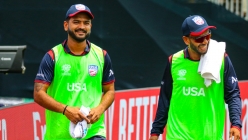USA Cricket: 2019 CWC League Two Florida Tri-Series Tour Report Card Part 2 – Player Grades
2019 Sep 26 by DreamCricket USA

Photo credit: Peter Della Penna
In part two of DreamCricket's tour report card of the Cricket World Cup League Two tri-series in Florida, each of the 12 players who took the field in the starting lineup for USA is graded on their performance from match to match.
By Peter Della Penna (Twitter @PeterDellaPenna)
For those unfamiliar with how individual players have been graded in the past as part of DreamCricket’s post-tournament report cards, each player is evaluated with regards to their specific role in the team on a match-by-match basis and not solely based on overall aggregate stats.
Players who excel under pressure and against higher quality opposition are graded more favorably. Overall chances given by a batsman, as well as overall chances created by a bowler, are taken into consideration regardless of total runs scored or wickets taken. Bonus marks are given for good fielding while a player can also be downgraded for weak fielding including dropped chances.
With those guidelines laid out, here are DreamCricket’s player grades for the 2019 Cricket World Cup League Two tri-series in Lauderhill, Florida, where USA finished 3-1 after sweeping their pair of matches against Papua New Guinea and splitting their set against Namibia.
Xavier Marshall: F
After starting off the year like a house on fire in the UAE and Namibia, Marshall’s bat has been extinguished of runs in the last two months. Just 41 runs off 85 balls in the four matches. As was the case in Bermuda, the issues appear to be more related to confidence than technical faults as Marshall basically refused to hit the ball for long stretches. He only hit two fours and a six in the entire tour and was immediate dismissed on the subsequent delivery after one of those fours and the six.
It’s not just Marshall’s batting that is the problem. As was the case in Bermuda, he tends to lose concentration in the field and at times produced some sloppy misfields along the ground. He was also partially at fault for throwing off Steven Taylor’s concentration on a skied chance in the ring that went to ground against Namibia when JP Kotze was on 96 on match day four.
Marshall promptly went back to New York after his failures in Florida and scored 106 off 46 balls, including 10 fours and nine sixes, for Villagers Social & Athletic Club in a Metropolitan League playoff match. That says a lot about the standard of club cricket in the USA because when the step up is made to international cricket and the boundary balls aren’t there three times an over, Marshall can’t get off strike. As one of the five players who was offered a one-year contract in July, USA Cricket may be stuck with Marshall for the foreseeable future as he tries to find a way to turn his form slump around.
Jaskaran Malhotra: D
Like his opening partner, Malhotra struggled to make scores in Florida. 32 of his 52 runs came in boundaries and another 10 in twos while he had 10 singles to round off his scoring. It means he scored off of just 23 of the 70 deliveries he faced, making 67% of the deliveries he faces dot balls. His inability to rotate strike allows pressure to build on him and his partner resulting in wickets. A classic case was his innings in the second day of the tri-series against Namibia. He started off with two boundaries in his first five balls, but scored just four singles off his next 17 deliveries before trying to play a release shot, slog sweeping a left-arm spinner flat to short midwicket.
The only reason Malhotra does not get an F is because of his clean wicketkeeping. He did not put down any chances behind the stumps during the week. But as has been written in previous reviews, he has not scored significant runs since his debut tour in February 2018. His career 50-over average for USA now stands at 21.26 in 32 innings. His status for upcoming tours depends on whether USA management is willing to use Monank Patel as a part-time keeper, or if they want to select someone else outright, but Malhotra very slow walk off the field after his 18 against Namibia on match day four looked like that of a player who knew the sand in his hourglass might have run out.
Steven Taylor: C+
A combination of a B for his bowling and a C- for his batting, Taylor continues to turn into American cricket’s greatest enigma. He is being picked first and foremost for his batting and is occupying prime real estate at No. 3. But barring his famous T20 knock against Canada in North Carolina last year, he has essentially been in batting limbo since the tour of Uganda in 2017.
Former coach Pubudu Dassanayake tried to convince Taylor to take on more responsibility and adjust his temperament to bat long, but that seems to have backfired spectacularly. Taylor’s unique selling point from the time he entered the team as a 16-year-old was his devastating power-hitting. That’s what helped make him the first USA player to break into the CPL with Barbados Tridents in the summer of 2015 as well. But as was the case in Bermuda last month, Taylor looks extremely reluctant to free his arms anymore. It was not a great surprise to see him go undrafted in the CPL for 2019 after four seasons of wasted opportunities. He does not have the technique nor the temperament to last 50 overs either.
The result is that he is now just a very pedestrian batsman and that is borne out by the stats. Taylor hit just six boundaries and three sixes on tour in his 93 runs in four innings, but his strike rate of 64.58 was below that of Monank Patel, who has never been known to race like a Lamborghini in one-day cricket. Quite simply, nobody in the opposition is losing sleep anymore worrying about how to bowl to Taylor. He’s also not a very easy player to bat with in partnership as was evidenced by Aaron Jones, who lost out on countless runs because of Taylor’s lazy approach toward taking a start at the non-striker’s end.
As for his bowling, that continues to be Taylor’s saving grace. His six wickets in this series – tied for second in the USA squad on tour – moved him into fourth place all-time on USA’s one-day records list behind only Usman Shuja, Elmore Hutchinson and Timil Patel. That’s a remarkable achievement considering how few overs Taylor bowled in the first half of his career but he has been a genuine bowling match-winner on occasion as was the case with his 4 for 23 against Namibia on match day two.
Taylor is generally sharp in the field these days but missed one chance at slip off Stephen Baard, but it only cost USA 13 runs. He is still USA’s best allrounder, but that is shading more toward the bowling than the batting side as of late.
Monank Patel: B
After failing miserably in Bermuda, Monank got things back on track quite quickly in Florida. Criticized by this writer for an inability to contribute runs under pressure, Monank did precisely that in his 66 off 99 balls against Papua New Guinea on match day three when everyone else in the batting order collapsed around him. His innings was crucial in victory to get USA to a fighting total and had it not been for Karima Gore’s momentum-shifting spell in the chase, Monank would have taken Player of the Match honors.
He also saw USA through to the end with an unbeaten 30 against Namibia on match day two, though that was a sloppy knock in which he gave three chances – on 6, 15 and 24, the last of which was a very obvious runout which the umpire mistakenly gave not out under the premise that the bowler broke the stumps before collecting the relay from midwicket which replays showed was not the case – albeit in a short chase that USA was unlikely to lose regardless. Overall, he was USA’s joint-leading scorer with 131 runs and was part of USA’s two highest partnerships on the week including a long stand with Aaron Jones
In the field, Monank is usually solid. He took two catches and spilled one very difficult chance running in from long-on off Assad Vala on the first day that cost USA 39 runs. This was a good rebound tour for Monank overall after a disastrous run in Bermuda and modest returns at WCL Division Two in Namibia and the prior tour of the UAE in March. USA should be able to depend on him going forward.
Aaron Jones: B+
USA’s most reliable batsman, Jones is almost always unflappable in the middle order and continues to be USA’s finest insurance policy since Aditya Thyagarajan. He ended the tour as the joint-leading scorer alongside Monank Patel with 131 runs in four innings.
He top-scored twice, making 77 on the opening day against PNG in a Player of the Match effort and looked genuinely devastated to get out short of what would have been USA’s maiden ODI century. He contributed two of USA’s three best partnerships on the week in that innings, adding 78 for the fourth wicket with Monank and crucially 58 for the seventh wicket in what turned out to be a five-run win on DLS Method.
Jones had two low scores in the next set of games. Taylor also did him no favors on at least one occasion with his lethargic approach at the non-striker’s end to help pinch the tight singles that are a staple of Jones’ game. Jones also top-scored with 44 in USA’s loss to Namibia on the final day. Some people at the ground were critical of Jones for not trying to hit out sooner but that is not his game and the loss was more tied to the regular failures of others in the batting order than anything Jones did wrong. Without him, the result would have been far uglier. He was eventually eighth out in what turned out to be the final over of the match, slog sweeping Zhivago Groenewald to deep square leg to start a triple-wicket over.
Jones is USA’s quickest runner between the wickets and along with Karima Gore their fastest outfielder. He spilled one extremely difficult chance running back from cover in the ring but it was a chance that probably only Gore would have gotten to of anyone else on the field. Overall, Jones continues to be a major contributor.
Karima Gore: B+
The left-arm spinner was USA’s leading wicket-taker on tour with nine scalps at 13.66 and an economy of 3.61. His grade and those figures would have been even better had he not struggled to bowl in windy conditions on the fourth match day when he was one of many who got rocked by Namibia’s Kotze, eventually ending with 0 for 63 in 10 overs.
Gore is always at his best when the pressure is at its highest and that was evident once again on both days against PNG. He bowled what may have been a vastly underappreciated spell in the opener, taking 3 for 25 in his five overs when PNG had a license to tee off in a 23-over chase. Gore then produced a Player of the Match effort in the rematch when his triple-wicket over as part of 4 for 20 overall turned a tense defense of 177 into a lopsided 62-run win.
With the bat, Gore was thrust up the order in the absence of Hayden Walsh Jr. and did a commendable job, finishing fourth overall on tour for USA with 72 runs with a best of 31. However, his fourth overall figure is more related to the failures of many above him. Gore’s best contribution was helping keep an end together for Jones on the opening day against PNG in a valuable 58-run seventh-wicket stand, one that helped get him promoted up the order for the remainder of the tour.
Gore is a livewire in the field and though he didn’t take any catches in this series, was USA’s best ground fielder overall, regularly denying singles in the ring and is quick to the ball on the boundary as well. He hasn’t taken a backward step since his March debut.
Nisarg Patel: C
A combination of B for his bowling and F for his batting. Nisarg’s left-arm spin is good enough for him to be considered a specialist and maybe that’s how he should be evaluated when it comes to selection going forward. On paper it may look like he only took six wickets in just 15 overs, but he bowled at key times and took big wickets, finishing with the best average of USA’s bowlers taking his wickets at 10.00 and an economy rate of 4.00.
Signficantly, he got Assad Vala out both times USA played PNG, both times lbw as well showing how his pace through the air as a spinner troubles high-class batsman. Vala was the leading scorer on the week and both times Vala got out against USA, they either stalled or outright crumbled. Though Gore got all the attention for his triple-wicket maiden in the second go around against PNG, Nisarg was the one who genuinely sparked the slide by removing Vala for 38 to make it 87 for 4 chasing a target of 178. Gore then exploited the breach to trigger a full-scale collapse of 6 for 7. He was only used for two overs against Namibia in the last match but showed he could be somewhat effective at the death taking two wickets in the final over, though he was also smacked for four and six. The only reason he isn’t bowling more overs is because of the surplus of options at USA’s disposal.
As for his batting, Nisarg could not turn around his repeated failures in Bermuda. After making scores of 1 and 6 at No. 7 and No. 6 respectively, he was dropped down to No. 8 for USA’s final match against Namibia and fared little better, making 3 off 15 balls before he drove a catch to cover. All three times, he was out to a left-arm spinner, showcasing an obvious vulnerability. 10 runs from three innings for a player batting in the 6-8 position is unacceptable in modern cricket.
Nisarg is a generally safe handed fielder – his one catch of the series was at long on to end Kotze’s century – and is quick to the ball along the ground. For the time being, he should be treated as a spinner and if he merits his selection on that front than there is room for him in the XI but even though he may have scored some runs in some intrasquad matches, he hasn’t transferred that to international level. When Hayden Walsh Jr. is available, it may mean Nisarg turns into a bench player which is no slight on Nisarg but more a highlight of USA’s spin depth at the moment.
Elmore Hutchinson: C+
A combination of B+ for his batting and D for his bowling. Hutchinson has made a habit over the years of topping the batting averages for USA on numerous tours with handy lower-order contributions to cover up for top-order failures. That practically held true again in Florida as he ended second on the averages behind Monank Patel with 71 runs at an average of 35.50. Those runs moved him into 10th place all-time on USA’s 50-over runs list and make him one of four players to be in the top ten in both runs and wickets all-time for USA in 50-over cricket (Taylor, Timil Patel and Orlando Baker), which is especially remarkable considering the fact that with a handful of exceptions when he was used as a pinch-hitter at No. 3, he has exclusively batted in the lower order his entire career.
His 42 not out off 21 balls at No. 9, including 24 off the final over, on the opening day against PNG on his ODI debut left PNG deflated and was massive in the final margin as USA defeated PNG by 5 runs on DLS Method. He struck the most sixes of anyone in the USA squad on tour with five and four of them came in that innings. He also scored a very valuable 28 off 24 balls against PNG in the rematch which came in a vital 48-run eighth-wicket partnership alongside Monank. His strike rate of 144.89 was nearly double the nearest teammate, Jaskaran Malhotra’s 74.28.
Hutchinson’s bowling was mostly ineffective though. He was wicketless in 13 overs and couldn’t build pressure either by at the very least tying down an end, going for 6.30 per over, the most expensive economy rate barring Rusty Theron whose figures are skewed because the only match he played was the 23-over chase on day one against PNG.
Hutchinson took a very sharp catch at short fine leg for his only take of the series, getting down low to intercept a flat sweep from Kotze in the second match of the series against Namibia to give Taylor his first wicket, spurring him on to a four-for. He is usually a very sure-handed catching fielder but is not as quick along the ground. This tour was a mixed bag for Hutchinson but he proved in key situations with the bat at the very least why his veteran presence is so instrumental for USA and how badly they missed him in Bermuda a month earlier.
Timil Patel: B-
Another solid but not spectacular tour for USA’s all-time leading wicket-taker. Timil took just four wickets in 25 overs. But crucially he was USA’s most economical bowler conceding his runs at just 3.20 per over.
He did not bowl a ball in PNG’s 23-over chase, but had a huge impact in the second over with his direct hit runout of the dangerous Tony Ura from mid-off. Though Taylor won Player of the Match for his 4 for 23 on the second day against Namibia, Timil’s spell of 10-4-25-2 heaped tremendous pressure to support Taylor at the opposite end.
Timil galvanized USA in the field in each of the last two matches, striking with his very first ball on both occasions. It is a huge lift to the team when they can count on a bowler to strike immediately and Timil has done that plenty of times over the last year.
With the bat, he did little. After scoring 3 off 15 balls in the opening match at No. 6, he was bumped down the order for the rest of the series. That is more a representation of his malleable role which fits the needs of the team on a match-by-match basis.
Aside from his runout in the opener, he took two catches. Timil has consistently been one of USA’s must reliable catching fielders in the ring, but his throwing arm is very weak, a consequence of longstanding shoulder issues. Still, he compensates for that deficiency through his consistent contributions with the ball, though his shoulder situation could change at any time in terms of its impact on his bowling and is something that needs monitoring over the next year.
Jessy Singh: D
The medium pacer mostly struggled through the series, regularly losing his runup while bowling into the wind. The no ball problems that have plagued him through his career and were especially costly on the tour of Bermuda were not corrected at all for this series – he bowled two each in the two matches against Namibia – and it continues to have a trickle-down effect on the rest of the bowling attack.
Singh went wicketless in two of three matches and bowled one exceptional spell in the series, coming on in the middle overs in the final match against Namibia. It began with a double-wicket maiden to have Kotze caught at long-on for 136 and Gerhard Erasmus chipping to midwicket for 20. The spell last five overs taking one more wicket of Zane Green to finish with 3 for 10 in that stretch. However, his before and after spells highlighted the Jekyll & Hyde nature of Singh.
He started off with a wicket on his first ball of the day but was taken off after two overs with the new ball after inconsistent lengths and bowling no balls with a line that read 2-0-22-1. Brought back at the death, his one over resembled an immature club cricketer desperate for a five-wicket haul instead of a seasoned international bowler who understood the needs of the team in the situation. Rather than bowl wide outside off with yorkers or just plain width to combat the wind that had been howling west all day, he kept on attacking the stumps, straight into the hitting arc of left-handed Jan Frylinck who torched him for 19 runs, which also included another no ball. He was taken off despite having overs remaining, which was a justifiable decision by captain Saurabh Netravalkar even if Singh was pining for a fifth wicket. He ended with an expensive overall economy rate of 5.40 in the context of a generally low-scoring series.
With the bat, he scored 11 in a valuable 26-run ninth-wicket partnership in the third match against PNG and was eventually last man out in the 49th over. He was bowled first-ball in the other innings he had against Namibia to cap Groenewald’s five-wicket haul. He didn’t take any catches in the field but is a decent fielder along the ground and patrolling the boundary.
Singh has the capacity to be a very good bowler for USA if he can achieve an element of consistency. But as long as the no balls continue to be an issue that hurt not just himself but the team, he is the first pace bowler on the chopping block to exit the XI when Rusty Theron is healthy and Ali Khan makes himself available.
Saurabh Netravalkar: C+
The USA captain continues to struggle to take wickets, ending with just two at an average of 40.50 in 23 overs, but he brings value in ODI cricket for his ability to build pressure by tying down an end as evidenced by his 3.52 economy rate.
Though the lack of wickets might not indicate it, Netravalkar was unplayable in some spells. He bowled 17 dot balls to start off the match on day two against Namibia, claiming Stephen Baard in his opening over as part of that stretch. He was superb on the opening day shortened chase by PNG, conceding four runs in his first two overs which contributed to the pressure leading to Ura’s runout. He then bowled a spectacular penultimate over of the match, producing three dots and conceding just six runs total when PNG needed 22 off 12 to start the frame. That pressure contributed to Theron dismissing Charles Amini for 53 to start the final over.
He was poor at the death on the final day against Namibia though. After taking Singh off in favor of himself, Netravalkar bowled no better in getting whacked for two sixes in a 16-run over.
Netravalkar showed some progress with regards to positivity in his field settings. He kept most fielders inside the circle on the second day against Namibia after an early collapse and at times put in a forward short leg or silly point in that match and during the day three collapse by PNG. The only obviously questionable move he made was taking off Singh during his sharp spell on the last day against Namibia when Singh was in a solid rhythm and had a chance to kill off the innings. The intent was to save some overs for the death but Singh didn’t look out of gas after straight five overs, even though he was running into the wind, and an opportunity was missed to capitalize on a rare sequence when Singh had found his rhythm and was troubling the opposition.
Netravalkar also was not as much of a liability in the field as he has been in the past. He held onto all three chances that came his way in the ring, though there were a few misfields along the ground. His overall performance was much better than it had been a month earlier in Bermuda.
Rusty Theron: C+
The 34-year-old former South African quick bowled economically with the new ball in the 23-over chase against PNG, building pressure that led to the runout of Ura. Given the ball for the final over and asked to defend 16 with Charles Amini on strike on 53, he bowled Amini to effectively seal the match. His figures of 1 for 37 in five overs in that match look worse than they were in person and his variations kept the PNG batsmen off balance.
Unfortunately, Theron was unfit for the rest of the series after picking up a leg strain in that spell. Fitness was part of the reason his South African international career was curtailed and he’ll be of little use to USA going forward if he can’t stay on the field.
Sagar Patel and Nosthush Kenjige: Incomplete.
Neither played a match all series.
Check out Part 1 - Team Grades. Coming up: Part 3 - Outlook for the 2019 CWI Super50 and CWC League Two December tri-series in the UAE.
[Views expressed in this article are those of the author, who was present at all of the team's matches on tour in Florida, and do not necessarily represent the views of DreamCricket management. If you have different views or opinions, we respect those views and urge you to provide your feedback, both positive and negative. Feel free to respond to the author via Twitter @PeterDellaPenna.]




